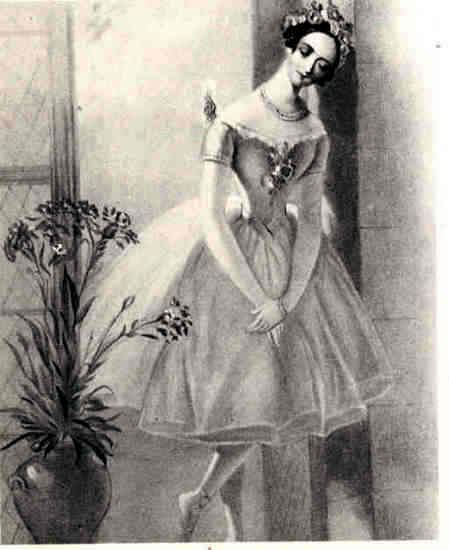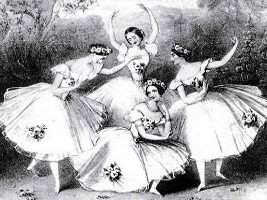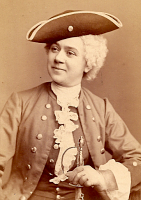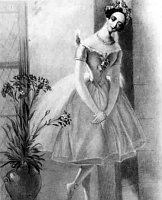Taglioni Family

The Taglionis were famous Italian dancers and choreographers during the 18th and 19th centuries. Carlo Taglioni was born in Turin and worked from 1782 until the turn of the century in Venice, Rome, Sienna and Udine. Two of his sons are important to the history of ballet. Filippo (1777- 1871), father of Marie (1804-1884), and Paul (1808-1884). Paul was the father of Marie the younger. Carlo's second son Salvatore (1789-1868), was father of Louisa (1823-1893), ballerina of the Paris Opera, and Fernando (1810-1874), who became a respected composer.
Filippo Taglioni (1777 - 1871, a long life even today), was an Italian dancer and choreographer, son of Carlo and father of Marie and Paul. Filippo would have been remembered on his own for his ballet LA SYLPHIDE and the fact that he was the father of the romantic ballet.
He first appeared in female roles in Pisa and later danced in Livorno and Florence before he danced in Paris. There he studied with Jean-Francois Coulon, and because Vestris and Gardel total controlled of the Opera he was more than happy to accept the position of principal dancer and ballet master in Stockholm in 1803. There he married his wife Sophia, daughter of Sweden's leading opera singer, and in 1804 his daughter Marie was born.
For several years the family lived in Vienna and Kassel, Germany. To escape the dangers of the Napoleonic wars, Filippo moved back to Paris. He started a freelance career through Italy, Sweden, Demmark, Germany and Austria. He was given a three year contract at the Karntnertor Theatre in Vienna. As soon as he was settled he sent for Marie, who had been studying in Paris. When she arrived he couldn't believe how badly she danced. He took her training on himself, making her practice six hours a day for six months, using a method much like the Cecchetti method that was to develop many years later. Filippo wanted a modest, light, delicate style and put emphasis on elevation and pointe technique.
In Stuttgart he continued to perfect Marie's technique, and when she was ready he took her back to Paris. After her debut she became so popular they were able to negotiate a six year contract for both of them. The triumphant opening of LA SYLPHIDE made her the prima ballerina of the romantic period and Filippo the most renowned choreographer. They traveled and toured Europe and Russia.
As he grew older, he became more eccentric. He lost all of Marie's carefully amassed fortune in unwise speculations. However, nothing in his later life can take away his achievements as a pioneer in the ballet style that was to alter the very nature of the art.
I am sure when I ask, "Who choreographed LA SYLPHIDE" most would answer Bournonville, but let me make this clear. The libretto was by Adolphe Nourrit -- choreography by Fillipo Taglioni, the father of the romantic ballet -- Premiere was March 12, 1832 at the Paris Opera -- danced by Marie Taglioni and Joseph Mazilier -- based on the story by Charles Nodier. An earlier version (1822) was L. Henry's LA SILFIDE.
August Bournonville staged his version of this ballet in 1836, starring Lucille Grahn and himself. His version is still being performed today and is the one we are familiar with.
Salvatore Taglioni was born in Palermo in 1789 and died in Naples in 1868. He was a dancer and choreographer. He was the son of Carlo, the brother of Filippo, and the father of Luisa, who made her career as a ballerina at the Paris Opera. Salvatore's son Fernando was a respected composer.
Salvatore, like his brother, studied dance with Jean-Francois Coulon. He danced mostly in Lyons and Bordeaux, and later established a very successful ballet school with Louis-Xavier-Stanislas Henry in Naples. He danced in many of his own ballets with his wife, Adelaide Perraud.
Paul Taglioni was born in Vienna in 1808 and died in Berlin in 1884. He was the son of Filippo, brother of Marie, and father of Marie the younger. He was trained in Paris by his father and Coulon. His other daughter, Augusta, became a famous actress in Berlin. Paul made his debut with his sister, and remained her partner for many years. He married ballerina Anna Galster in Berlin. Anna and Paul toured America in 1839. While there he prepared some of American's first dancers to take their places in the ballet world. In Germany he was as famous as the rest of his family. He staged over 40 ballets starring his daughter.
Marie was very difficult and made demands on the Opera management, but because of her success, they had no choice but to give in to her. She had Jules Perrot fired because he got more applause than she did. In London at this time Fanny Elssler was having a great success at the King's Theatre. Marie was considered light, ethereal, sylphlike; Fanny, human, earthbound, voluptuous. Dr. Vernon, the director of the Paris Opera, went to London to see this ballerina. He was convinced that the French audiences would love her. Dr. Vernon offered her a contract, but before she would appear she spent three months studying with Auguste Vestris. In 1934 Fanny made her debut at the Paris Opera in Coralli's ballet LA TEMPETE. Her first performance divided Paris into two camps. (Balletomanes have always found it hard to love more than one star at a time).
Marie, feeling that her dictatorial reign had received a setback, married Count Gelbeit de Voisins in 1835, but the marriage ended in divorce. With Fanny rising in the ranks, Marie and her father accepted a profitable 3-year contract in St. Petersburg (1837-1839). The Russian audience loved her and the new romantic ballet. Marie wrote to her Russian audience, "Eternally you are written in my heart; if I bid Russia farewell, believe me, it is not forever." A pair of her toe shoes sold for two hundred roubles and was used to make a sauce that was piously eaten at a memorial dinner of fanatical balletomanes.
When she returned to the West she continued to dance with great success until her retirement. She settled on her estate near Venice, but because of her father's misuse of her money, she became bankrupt and was forced to teach ballroom dance and deportment in London and Paris. Marie died in Marseilles, France, in poverty. The year was 1884.
(First published February 1993)


